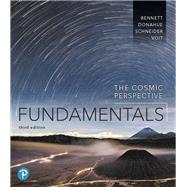For one-semester courses in introductory astronomy.
A brief path through astronomy that helps students gain an appreciation for astronomy and discovery in science
The Cosmic Perspective Fundamentals is the briefest introduction to astronomy in the Bennett series and supports instructors using an active or collaborative approach to teaching. By focusing on the process of science and fundamental concepts of astronomy, The Cosmic Perspective Fundamentals allows time for the use of other instructional tools in the course. Each concisely written chapter is formatted into two main sections followed by a Process of Science section, making learning targeted and expectations clear for students.
The 3rd Edition of The Cosmic Perspective Fundamentals features major scientific updates, new content that focuses on the possibility of life in the universe, and recent discoveries that provide modern contexts to help students see the relevance of astronomy to their worlds. The authors write and create a wealth of Mastering Astronomy resources that include a new Pearson eText, Dynamic Study Modules, and Interactive PreLecture videos that students can use before, during, and after class, including pre-built assignments that instructors can edit to fit the way they teach.
Also available with Mastering Astronomy:
Mastering™ is the teaching and learning platform that empowers you to reach every student. By combining trusted author content with digital tools developed to engage students and emulate the office-hour experience, Mastering personalizes learning and improves results for each student. Resources in Mastering Astronomy are written and carefully reviewed by the author team, establishing the same coherent and trusted voice as the book.
If you would like to purchase both the physical text and Mastering Astronomy, search for:
013499079X / 9780134990798 The Cosmic Perspective Fundamentals Plus Mastering Astronomy with Pearson eText -- Access Card Package
Package consists of:
- 0134988507 / 9780134988504 The Cosmic Perspective Fundamentals
- 0134989279 / 9780134989273 Mastering Astronomy with Pearson eText -- ValuePack Access Card -- for The Cosmic Perspective Fundamentals
- 0321765184 / 9780321765185 SkyGazer 5.0 Student Access Code Card (Integrated component)
Note: You are purchasing a standalone book; Pearson eText and Mastering Astronomy do not come packaged with this content. Students, ask your instructor for the correct package ISBN and Course ID. Instructors, contact your Pearson representative for more information.








